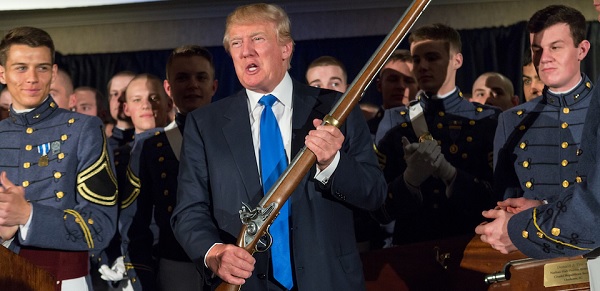The candidate who once warned America about Hillary Clinton’s hawkishness is turning into a war machine.
By Jennifer Wilson, Micah Zenko, August 9, 2017, Foreign Policy.

Throughout the 2016 campaign, many people opposed to Donald Trump’s candidacy were nonetheless reluctant to endorse Hillary Clinton, in part because of her relative hawkishness. Candidate Trump had a decades-long career in the public eye that demonstrated plenty of reason to worry he would be a disastrous president, but he lacked the long career in public service that fueled worries about Clinton’s approach to the use of force, and her alleged desire to expand executive war-making powers past what she inherited from her predecessor.
Six months into Trump’s presidency, we now have enough data to assess his own approach. The results are clear: Judging from Trump’s embrace of the use of air power — the signature tactic of U.S. military intervention — he is the most hawkish president in modern history. Under Trump, the United States has dropped about 20,650 bombs through July 31, or 80 percent the number dropped under Obama for the entirety of 2016. At this rate, Trump will exceed Obama’s last-year total by Labor Day.
In Iraq and Syria, data shows that the United States is dropping bombs at unprecedented levels. In July, the coalition to defeat the Islamic State (read: the United States) dropped 4,313 bombs, 77 percent more than it dropped last July. In June, the number was 4,848 — 1,600 more bombs than were dropped in any one month under President Barack Obama since the anti-ISIS campaign started three years ago.
In Afghanistan, the number of weapons released has also shot up since Trump took office. April saw more bombs dropped in the country since the height of Obama’s troop surge in 2012. That was also the month that the United States bombed Afghanistan’s Mamand Valley with the largest non-nuclear bomb ever dropped in combat.
Trump has also escalated U.S. military involvement in non-battlefield settings — namely Yemen, Somalia, and Pakistan. In the last 193 days of the Obama presidency, there were 21 lethal counterterrorism operations across these three countries. Trump has quintupled that number, conducting at least 92 such operations in Yemen, seven in Somalia, and four in Pakistan.
Hand in hand with Trump’s enthusiasm for air power comes a demonstrated tolerance for civilian casualties.
Hand in hand with Trump’s enthusiasm for air power comes a demonstrated tolerance for civilian casualties. Increased air power in Iraq and Syria has resulted in unprecedented levels of civilian deaths. Even by the military’s own count, civilian casualties have soared since Trump took office, though independent monitors tally the deaths as many as ten times higher. In Afghanistan, Trump’s tolerance for killing civilians has led to 67 percent more civilian casualties in his first six months than in the first half of 2016, according to the United Nations.
The expansion of air power and acceptance of civilian harm are together a problem, but they are made worse by the fact that they are occurring without any diplomatic strategy to wind down the wars. The counter-Islamic State strategy review that Trump ordered in January has twice missed deadlines the president set for himself and remains incomplete. Secretary of Defense James Mattis promised Sen. John McCain (R-Ariz.) that he would have a strategy for the war in Afghanistan by mid-July, yet that review is still ongoing. Even while Mattis has called for a diplomatic solution to the conflict in Yemen, the approach is incoherent with Trump’s doubling-down on airstrikes and support for the Saudi-led coalition conducting its own indiscriminate bombing campaign.
The connection between increased air power and a reduction in hostilities is made even more tenuous by the gutting of the State Department, which Trump has proposed cutting funding by around 30 percent and for which dozens of critical senior posts remain vacant. Without the expertise and resources of a fully staffed diplomatic corps, it’s implausible that there will ever be a U.S.-led or U.S.-supported negotiated political settlement between combatants. In the absence of any coordinated approach to ending these conflicts, Trump is resorting to the default tactic that policymakers have become addicted to over the past nine years: low-cost, low-risk (to U.S. service members) standoff strikes. Under Trump, that military addiction has deepened, demonstrably so.








